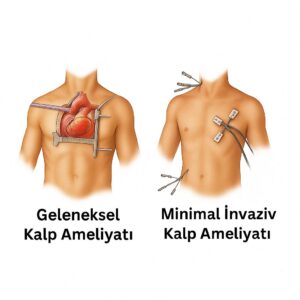What is closed bypass? This term, frequently heard in recent years, is actually used to describe coronary bypass surgeries performed with minimally invasive methods.

An expression we’ve been encountering frequently lately, especially on social media: Closed bypass surgery. This term has become quite popular among patients, and many people planning heart surgery have started to frequently ask the question, ‘Is closed bypass possible?’ However, there is no surgical method defined as ‘closed bypass’ in medical literature. Therefore, it’s crucial to clarify this issue.
In medicine, when we say ‘closed method,’ it generally means accessing body cavities with cameras and special surgical instruments, and performing the operation through small incisions instead of traditional large cuts. However, in the method called ‘closed bypass,’ an incision is actually made into the chest cavity. This incision is usually made from the left side of the chest, from the area below or above the breast. Therefore, technically, this is not a closed surgery. It’s just an incision that allows us to reach the heart from the side between our ribs, instead of reaching the heart through the breastbone from the front of the chest. All other stages of the surgery are the same.
For this reason, terms like ‘minimally invasive coronary bypass’ or ‘coronary bypass with small incision’ are more medically accurate than ‘closed bypass.’ In fact, even the terms minimally invasive bypass or small incision are not entirely appropriate for this surgery. This technique actually extends the operation time compared to the classic surgery and makes the operation more complex. Perhaps the term ‘side incision’ might be a more suitable description.
Is Every Patient Suitable for Closed Bypass (Minimally Invasive) Surgery?
No. Not every patient is suitable for this method. Coronary bypass surgery is a life-critical operation that needs to be taken seriously. Wrong technical choices should not be made due to aesthetic concerns or to shorten the recovery period. The primary priority is to perform the surgery with minimal risk and to provide effective long-term results.
Many variables such as the number of diseased vessels, the location of the blockage, and heart functions directly affect this decision. For example, in cases where bypassing only the vessels on the front surface of the heart is sufficient, if there is a suitable vascular structure, bypass with a side incision may be preferred.
However, in cases of multiple vessel diseases or the presence of heavy calcification, traditional open methods may provide both safer and more lasting results.
Is Closed Bypass Surgery Frequently Used?
Although the feasibility of these surgeries has increased with the development of some surgical instruments in recent years, it has not yet replaced classic coronary bypass surgery.
Scientific studies have not yet demonstrated the superiority of this method over open surgery. Therefore, closed bypass surgeries are not a widespread practice.
Is It Possible to Recover Faster with Closed Bypass?
The recovery period for coronary bypass surgeries is generally 3-4 weeks. A significant part of this period is devoted to the healing of the breastbone. In closed bypass surgery performed with a side incision, theoretically, healing may be faster as the breastbone is not cut. However, to date, there is no comprehensive clinical data clearly demonstrating this difference.
When applied to suitable patients, a more comfortable recovery period of 2-3 weeks has been observed. However, it should be remembered that this situation may vary from patient to patient.
The Difference Between Robotic Surgery and Closed Bypass
Fully robotic closed bypass surgery is not yet a widespread practice. The main reason for this is that it’s technically difficult to reach all the vessels of the heart and perform anastomosis procedures (vessel suturing) with the help of a robot.
However, robotic surgery is used as an auxiliary element in minimally invasive coronary bypass surgeries. Especially in LIMA-LAD (internal mammary artery-left anterior descending artery) anastomoses, the robot both allows for a smaller incision size and provides the surgeon with more control during the operation.
Conclusion: Closed Bypass or Minimally Invasive Bypass?
In conclusion, there is no term such as ‘closed bypass’ in medical literature. However, minimally invasive coronary bypass surgery or the side incision technique is a method that can shorten the recovery period when applied to the right patients. Therefore, the actual name of the method known to the public as closed bypass should be ‘coronary bypass surgery with side incision.’
It should be remembered that coronary bypass surgery is a vital procedure, not an aesthetic one. The most appropriate surgical technique should be decided based on the patient’s condition, vascular structure, and the surgeon’s experience.
